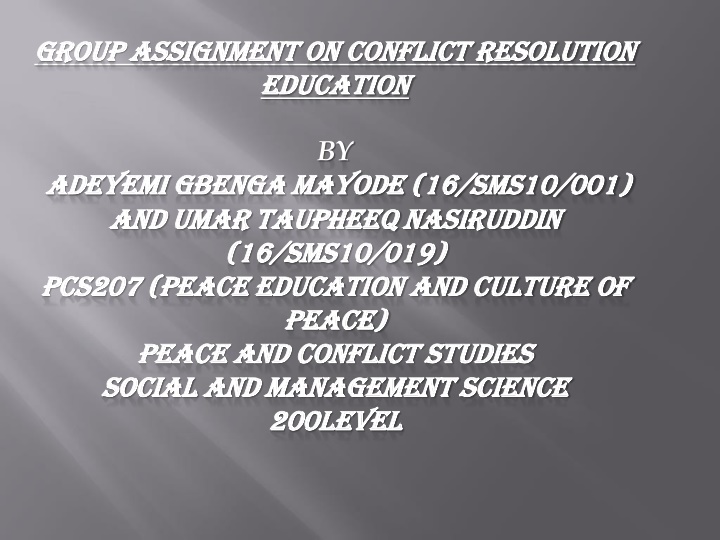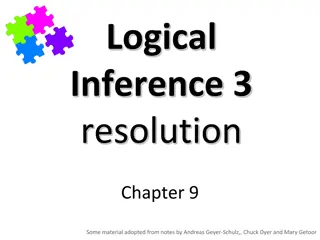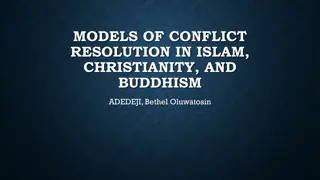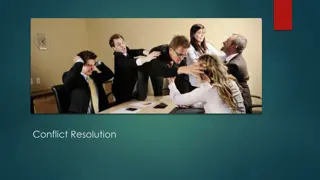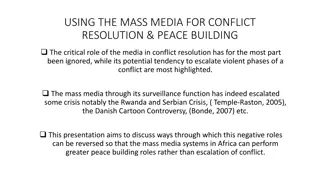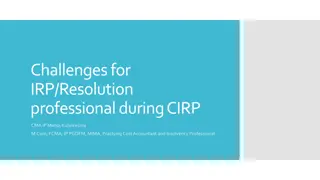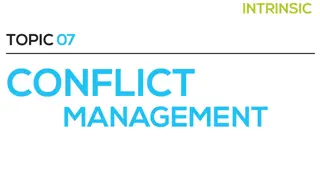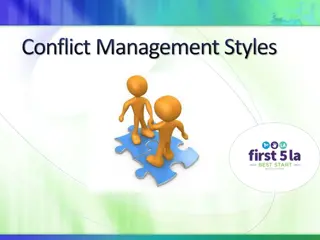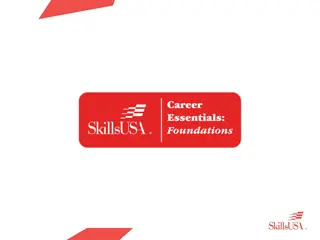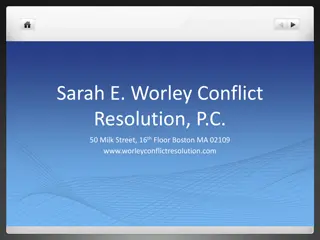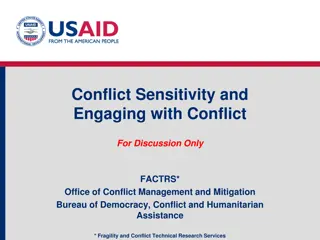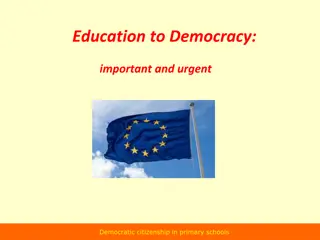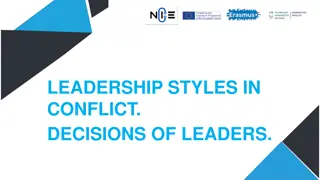Effectiveness of Conflict Resolution Education in Schools
Conflict resolution education plays a crucial role in transforming school environments by reducing violence and promoting win-win outcomes. Various successful programs have shown significant improvements in school settings, such as reduced suspensions and conflicts among students. Conflict resolution education aims to create a safe and inclusive learning environment where students can work together harmoniously while respecting diversity. Essential processes include negotiation, mediation, and consensus building. The impact of conflict resolution programs, like the Resolving Conflict Creatively Program, has been positive, with improvements reported in classroom climate, decrease in violence, and enhanced conflict resolution skills among students.
Download Presentation

Please find below an Image/Link to download the presentation.
The content on the website is provided AS IS for your information and personal use only. It may not be sold, licensed, or shared on other websites without obtaining consent from the author.If you encounter any issues during the download, it is possible that the publisher has removed the file from their server.
You are allowed to download the files provided on this website for personal or commercial use, subject to the condition that they are used lawfully. All files are the property of their respective owners.
The content on the website is provided AS IS for your information and personal use only. It may not be sold, licensed, or shared on other websites without obtaining consent from the author.
E N D
Presentation Transcript
GROUP ASSIGNMENT ON CONFLICT RESOLUTION GROUP ASSIGNMENT ON CONFLICT RESOLUTION EDUCATION EDUCATION BY ADEYEMI GBENGA MAYODE (16/SMS10/001) ADEYEMI GBENGA MAYODE (16/SMS10/001) AND UMAR TAUPHEEQ NASIRUDDIN AND UMAR TAUPHEEQ NASIRUDDIN (16/SMS10/019) (16/SMS10/019) PCS207 (PEACE EDUCATION AND CULTURE OF PCS207 (PEACE EDUCATION AND CULTURE OF PEACE) PEACE) PEACE AND CONFLICT STUDIES PEACE AND CONFLICT STUDIES SOCIAL AND MANAGEMENT SCIENCE SOCIAL AND MANAGEMENT SCIENCE 200LEVEL 200LEVEL
Conflict resolution is and has been a powerful curriculum force in schools for years; today, even more attention is being paid to conflict resolution education. But just how effective is conflict resolution education in reaching its goals of eliminating verbal and physical violence and increasing the number of win-win outcomes in schools? Yes, it is possible for conflict resolution programs to change a school's environment! "Conflict Resolution Education: A Guide to Implementing Programs in Schools, Youth-Serving Organizations, and Community and Juvenile Justice Settings," a joint report from the Office of Juvenile Justice and Delinquency Prevention and the Office of Elementary and Secondary Education, cites examples of effective conflict resolution programs. Among those success stories are these: Five of the six New York City high schools participating in Project S.M.A.R.T. (School Mediator Alternative Resolution Team) had a 45 to 70 percent reduction in suspensions for fighting during the program's first year of operation. The Clark County Social Service School Mediation Program in Nevada, during the 1992-1993 school years, reduced conflict among students in two participating elementary schools and helped prevent fights among students. After the program, the number of teachers who spent less than 20 percent of their time on discipline increased by 18 percent. Similar results were reported for the 1993-1994 school year.
Evaluations of the impact of the Resolving Conflict Creatively Program (RCCP) in four multiracial, multiethnic school districts in New York City showed that 84 percent of teachers who responded to a survey reported positive changes in classroom climate, 71 percent reported moderate or significant decreases in physical violence in the classroom, and 66 percent observed less name-calling and few verbal insults. More than 98 percent of respondents said that mediation gave children a significant tool for handling conflicts. 'CONFLICT RESOLUTION EDUCATION' According to the "Conflict Resolution Education" report, the purposes of conflict resolution are to provide an environment in which "each learner can feel physically and psychologically free from threats and danger and can find opportunities to work and learn with others for the mutual achievement of all. The diversity of the school's population is respected and celebrated." The report offers negotiation, mediation, and consensus of decision making as the three essential processes of conflict resolution. It goes on to define several basic approaches to conflict resolution education, including: Process Curriculum. This approach is characterized by teaching conflict resolution as a separate course, a distinct curriculum, or a daily lesson plan. Peaceable Classroom. This approach integrates conflict resolution education into the curriculum and classroom management strategy. Peaceable Schools. Built on the peaceable classroom approach, this strategy uses conflict resolution as a system for managing the school as well as the classroom. Every member of the school community, including parents, learns conflict resolution principles and processes.
The approaches often overlap in actual schools or other institutions. Here's a look at how some of the approaches work. PROCESS CURRICULM APPROACH The Peace Education Foundation (PEF) provides a grade-level-specific curriculum for prekindergarten through grade 12 that has a unified sequence of content and skills. To entrench conflict resolution in schools, PEF programs are purposefully tied to school improvement. The content of the PEF curriculum is grouped into five components: community building, understanding conflict, perception (understanding different viewpoints), anger management, and Rules for fighting fair. PEF's curriculum also includes mediation in grades 4 through 12. It provides instructions for training peer mediators and overseeing a school-based mediation program. PEACEABLE CLASSROOM APPROACH In peaceable classrooms, teachers use the cooperative learning and academic controversy methods developed by David Johnson and Roger Johnson. Students work in small groups to achieve shared learning goals. Academic controversy methods are used when two students disagree. Deliberate discourse -- the discussion of the advantages and disadvantages of proposed actions -- is how controversies are resolved.
Educators for Social Responsibility (ESR), based in Cambridge, Massachusetts, fosters children's ethical and social development through its programs in conflict resolution, violence prevention, intergroup relations, and character education. ESR defines the term peaceable as meaning a "safe, caring, respectful, and productive learning environment." A major premise of ESR is that teachers learn to model the behavior they teach through direct instruction, and schools assume the values they seek to nurture among young people in all facets of their program. As an example of how ESR operates, it recommends that students and teachers make decisions together about classroom norms at the beginning of the school year and that teacher give early instruction in problem solving and decision making so the skills can be used and reinforced throughout the year. PEACEABLE SCHOOL APPROACH The Resolving Conflict Creatively Program (RCCP), an initiative of ESR, involves five components: professional development for teachers and other staff, regular classroom instruction based on a K-12 curriculum, peer mediation, administrator training, and parent training.
Teachers who want to implement RCCP in their classrooms take a 25-hour introductory course, giving them the opportunity to receive feedback on their lessons and see skilled practitioners give demonstration lessons in the classroom. Teachers are encouraged to devote 30 to 45 minutes at least once a week for a specific workshop in conflict resolution prepared from the curriculum guide. Teachers also include conflict resolution lessons, strategies, and skills into the regular academic program. Schools agree to implement the RCCP curriculum for at least a year before beginning peer mediation, which will reinforce the problem-solving skills already being developed in classrooms. Other key elements in RCCP are administrator training and parent training. Parents participate in a 12-hour workshop on the skills and concepts of conflict resolution and intergroup relations in order to make their homes more peaceful. That way, parents can help their children become more skilled in the conflict resolution they are learning in school. Said a ninth-grade student from Vista, California, "I've seen changes in some of the kids at school since we started this program. They look at things differently now. They don't act the same; they try to be more peaceful now. I think we are really changing the gangs on this campus. There used to be a lot of gangs before, writing in the bathrooms and all that, but it's sort of stopped. It's more peaceful now."
